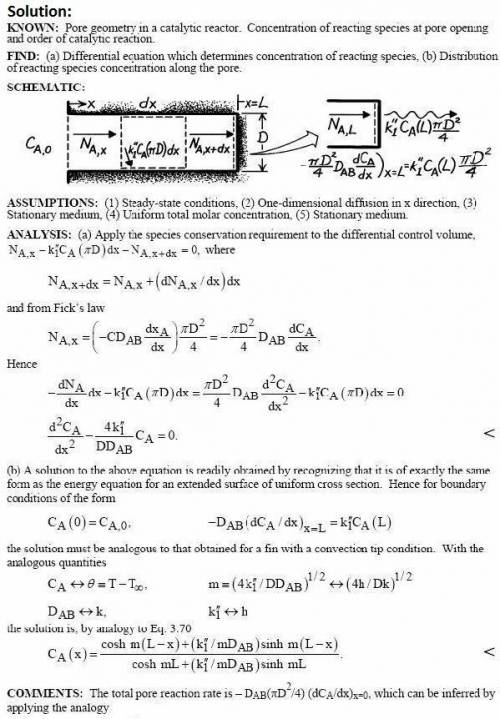
Physics, 11.04.2020 03:07, aredding6282
To enhance the effective surface, and hence the chemical reaction rate, catalytic surfaces often take the form of porous solids. One such solid may be visualized as consisting of a larger number of cylindrical pores, each of diameter D and length L.
Consider conditions involving a gaseous mixture of A and B for which species A is chemically consumed at the catalytic surface. The reaction is known to be first order k1CA. Under steady state, flow over the porous solid is known to maintain a fixed value of the molar concentration CA0 at the pore mouth.
Beginning from fundamentals, obtain the differential equation that governs the variation of CA with distance x along the pore. Applying appropriate boundary conditions, solve the equation to obtain an expression for CA(x).

Answers: 1
Other questions on the subject: Physics

Physics, 22.06.2019 19:00, ramjand7853
Achild has maximum walking speed of 1.6 m/s. what is the length of the child's legs? 0.26 m
Answers: 2

Physics, 22.06.2019 19:30, CalCDanG
Assume that two of the electrons at the negative terminal have attached themselves to a nearby neutral atom. there is now a negative ion with a charge -2e at this terminal. what are the electric potential and electric potential energy of the negative ion relative to the electron? the electric potential and the electric potential energy are both twice as much. the electric potential is twice as much and the electric potential energy is the same. the electric potential is the same and the electric potential energy is twice as much. the electric potential and the electric potential energy are both the same. the electric potential is the same and the electric potential energy is increased by the mass ratio of the oxygen ion to the electron. the electric potential is twice as much and the electric potential energy is increased by the mass ratio of the oxygen ion to the electron.
Answers: 3

Physics, 22.06.2019 20:30, nae467
Suppose a force of 60 n is required to stretch and hold a spring 0.1 m from its equilibrium position. a. assuming the spring obeys hooke's law, find the spring constant k. b. how much work is required to compress the spring 0.5 m from its equilibrium position? c. how much work is required to stretch the spring 0.6 m from its equilibrium position? d. how much additional work is required to stretch the spring 0.1 m if it has already been stretched 0.1 m from its equilibrium? a. kequals 600
Answers: 2

Physics, 23.06.2019 00:00, zachzach28280
Why does a collision with an airbag cause less damage than a collision with a steering wheel
Answers: 1
Do you know the correct answer?
To enhance the effective surface, and hence the chemical reaction rate, catalytic surfaces often tak...
Questions in other subjects:

History, 03.07.2019 09:00




Biology, 03.07.2019 09:00


Mathematics, 03.07.2019 09:00

Mathematics, 03.07.2019 09:00

Mathematics, 03.07.2019 09:00







